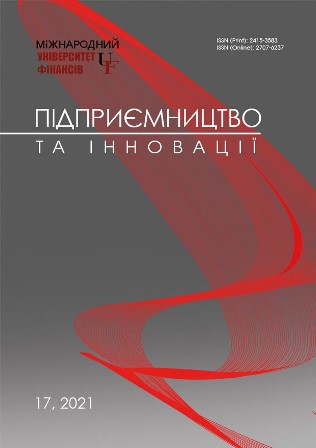PRINCIPLES AND FEATURES OF THE CUSTOMS CONTROL SYSTEM IN THE EU
Abstract
The article analyzed the system of customs control in the EU, the principles and features of customs clearance and the determination of the level of risks. Modern socio-economic conditions for the development of the world and national economy, active integration processes determine the need for constant updating and improvement of the customs control system, which, on the one hand, should provide a high level of response to the occurrence of probable risks during customs clearance, and on the other hand, to promote the development of trade relations between countries. The EU Customs Codex is a system of norms related directly to the passage of goods through customs, aimed at the general organization of customs control and customs procedures and regulating responsibility for possible offenses in the customs sphere. It is determined that customs control is carried out within the framework of the general risk management system, which is based on the exchange of information on risks and the results of risk analysis between customs authorities and establishes common criteria and risk standards. The development of new technologies and increasing trade flows within the EU and with other countries determine the need for constant monitoring of the state of the existing system of customs control and customs risk management and its improvement. To this end, relevant software products that are actively used by customs administrations of EU countries have been developed and updated. It was emphasized that one of the elements of the customs control system in the EU is the general declaration of arrival, which is a component of preliminary informing in the context of identifying security risks, checking the reliability of supply chains of goods, and is an e-mail with a set of relevant data, and has already been introduced in Ukraine, which is an important step towards the introduction of international customs control standards in Ukraine and the future accession to the common transit procedure. The introduction of fundamentally new programs and tools of customs control, which minimize the likelihood of customs risk and at the same time allow reducing the time of customs clearance and total costs, is an important stage in our country's entry into the Pan-European economic space.
References
Кузняк Б.Я., Свічкарь В.А. Особливості митного регулювання в країнах Європейського Союзу. Ефективна економіка. 2018. № 4. URL: http://www.economy.nayka.com.ua/?op=1&z=6221 (дата звернення: 25.03.2021).
Регламент Європейського Парламенту і Р(ЄС) № 952/2013 від 9 жовтня 2013 р. про встановлення Митного кодексу Союзу. База даних «Законодавство України». URL: https://zakon.rada.gov.ua/laws/show/ru/984_009-13?find=1&lang=ru&text=%D0%BC%D0%B8%D1%82%D0%BD%D0%B8%D0%B9+%D0%BA%D0%BE%D0%BD%D1%82%D1%80%D0%BE%D0%BB%D1%8C#w2_3 (дата звернення: 25.03.2021).
Щербатюк Н.В. Організація митного контролю: європейський досвід. Часопис Київського університету права. 2020. № 1. С. 387–391.
Міжнародна конвенція про спрощення і гармонізацію митних процедур (Кіотська конвенція). База даних «Законодавство України». URL: https://zakon.rada.gov.ua/laws/show/995_643#Text (дата звернення: 25.03.2021).
Державна митна служба України. URL: https://customs.gov.ua (дата звернення: 25.03.2021).
Закон України «Про режим спільного транзиту та запровадження національної електронної транзитної системи». База даних «Законодавство України». URL: https://zakon.rada.gov.ua/laws/show/78-IX#Text (дата звернення: 25.03.2021).
Kuzniak B.Ia., Svichkar V.A. (2018). Osoblyvosti mytnoho rehuliuvannia v krainakh Yevropeiskoho Soiuzu [Features of customs regulation in the European Union]. Efektyvna ekonomika. 4, URL: http://www.economy.nayka.com.ua/?op=1&z=6221 (accessed 25 March 2021).
Rehlament yevropeiskoho parlamentu i rady (IeS) № 952/2013 vid 9 zhovtnia 2013 roku pro vstanovlennia Mytnoho kodeksu soiuzu. Baza danykh «Zakonodavstvo Ukrainy». URL: https://zakon.rada.gov.ua/laws/show/ru/984_009-13?find=1&lang=ru&text=%D0%BC%D0%B8%D1%82%D0%BD%D0%B8%D0%B9+%D0%BA%D0%BE%D0%BD%D1%82%D1%80%D0%BE%D0%BB%D1%8C#w2_3 (accessed 25 March 2021).
Shcherbatiuk N. V. (2020). Orhanizatsiia mytnoho kontroliu: yevropeiskyi dosvid [Organization of customs control: European experience] Chasopys Kyivskoho universytetu prava .1. p.p. 387-391 [in Ukrainian].
Mizhnarodna konventsiia pro sproshchennia i harmonizatsiiu mytnykh protsedur (Kiotska konventsiia). Baza danykh «Zakonodavstvo Ukrainy». URL: https://zakon.rada.gov.ua/laws/show/995_643#Text (accessed 25 March 2021).
Derzhavna mytna sluzhba Ukrainy. URL: https://customs.gov.ua (accessed 25 March 2021).
Zakon Ukrainy «Pro rezhym spilnoho tranzytu ta zaprovadzhennia natsionalnoi elektronnoi tranzytnoi systemy». Baza danykh «Zakonodavstvo Ukrainy». URL: https://zakon.rada.gov.ua/laws/show/78-IX#Text (accessed 25 March 2021).



